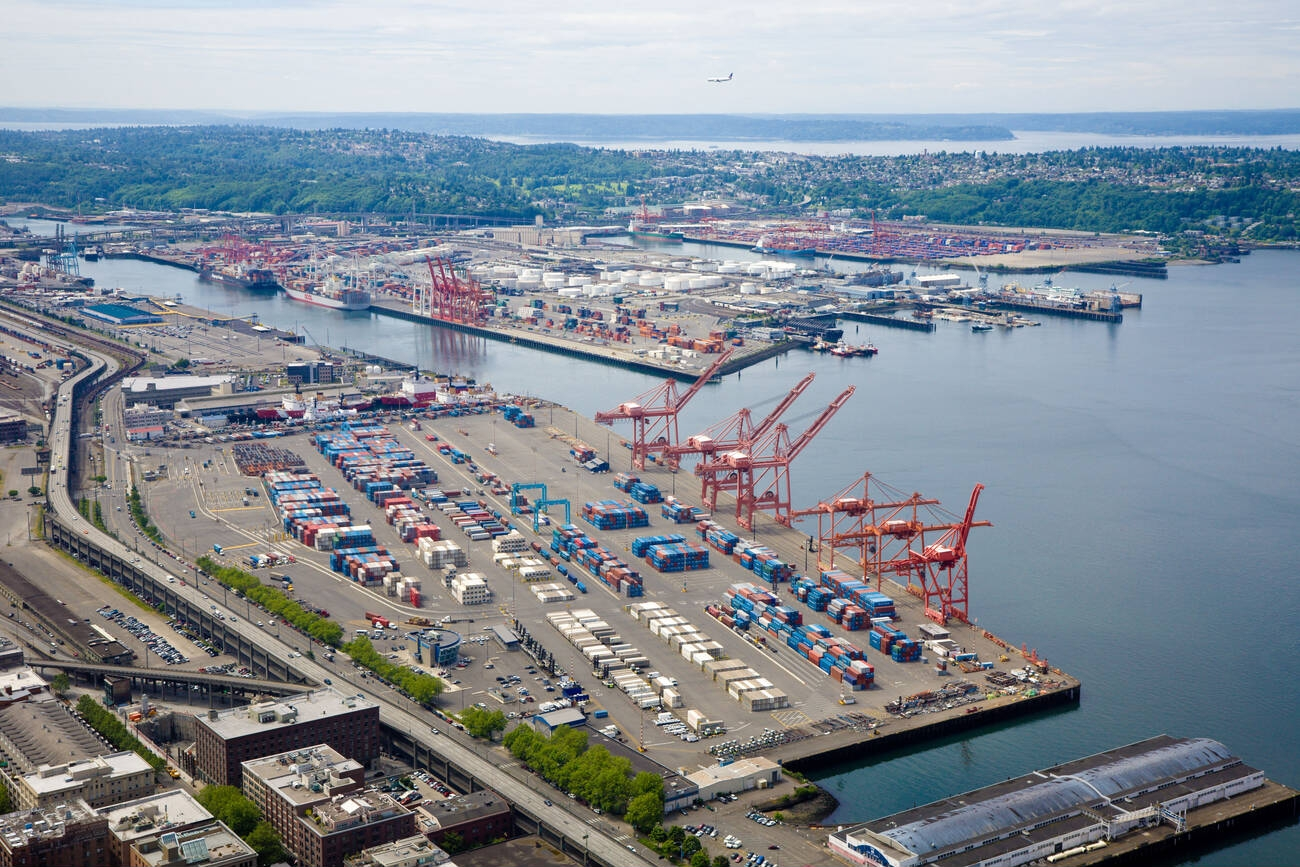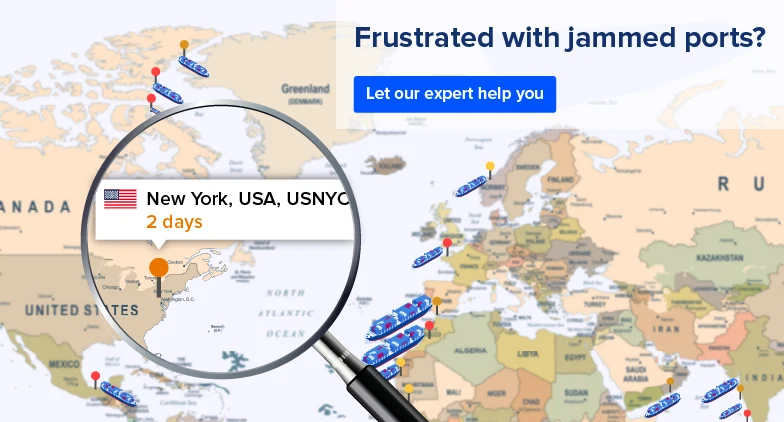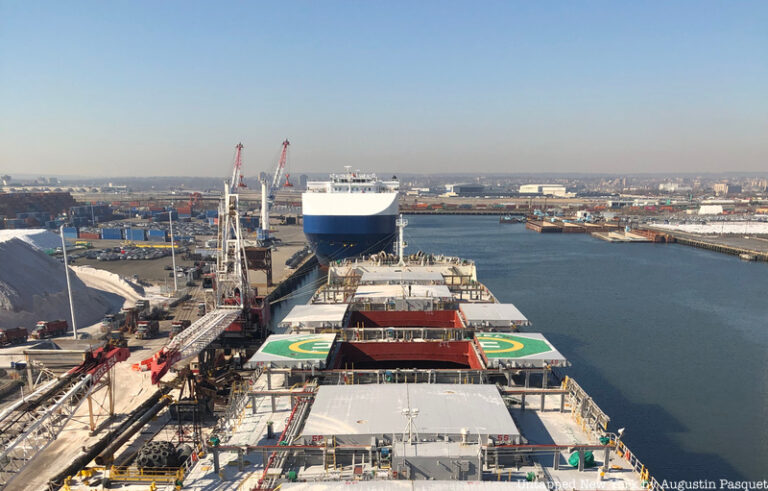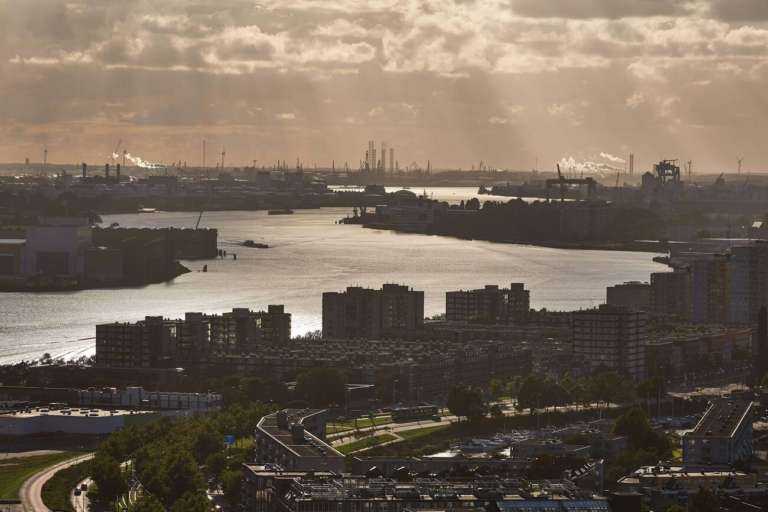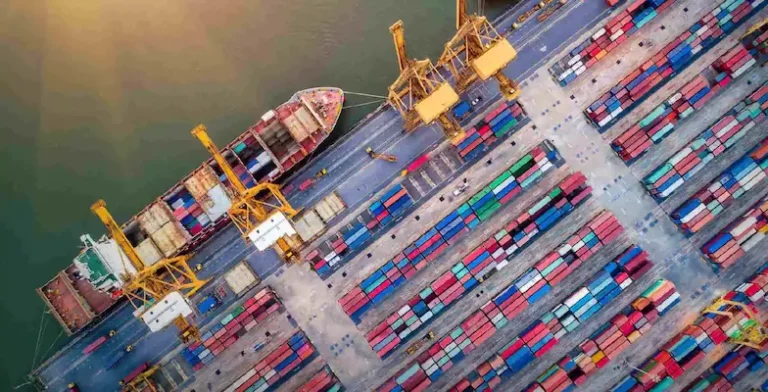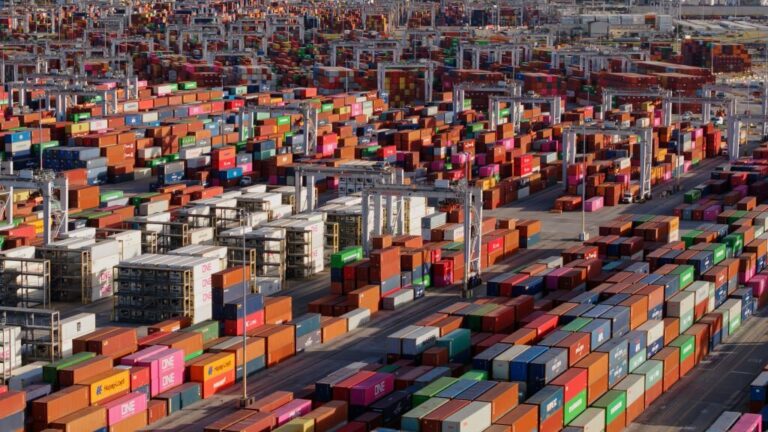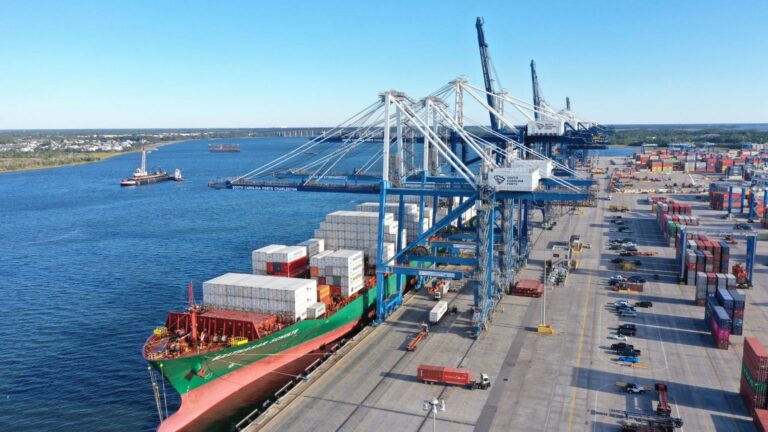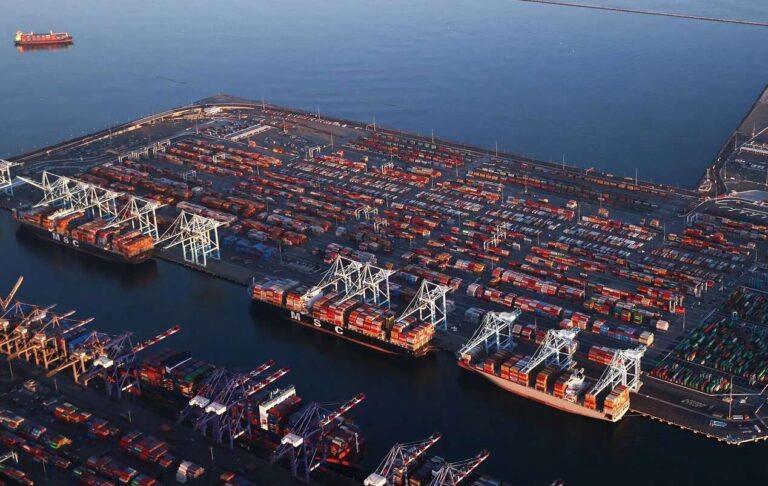Top 12 Major Ports in North America 2025: Leading the Maritime Economy
Did you know that 90% of the world trade is carried out through the Ocean? Think of the ports as bustling arteries connecting nations and facilitating the exchange of vital goods, from nourishing food supplies to fuel- the lifeblood of economies.
These ports aren’t just concrete and steel structures, they are the hearts of economic activity, supporting international exchange.The amount of cargo a port handles and its size determine how much of an impact it has on the economy.
In the vast spectrum of global trade, North America emerges as a key protagonist, with its ports serving as vital connectors linking the continent to the wider world. As a result, you should consider our compilation of the top twelve ports in North America to be some of the biggest hubs for commerce.
Strategic Importance in Global Trade
Around 50% of the total global trade in value terms is maritime, which reaches up to 76% for the mining and quarrying sector. These ports play a critical role in global trade, serving as key transit points for cargo moving between continents.
Ports in North America, situated along the Atlantic and Pacific Oceans, possess a strategic geographic advantage. This prime positioning allows them to serve as crucial entry and exit points for goods moving between the Americas, Europe, and Asia. Additionally, North American ports are equipped with advanced infrastructure and technology, enabling efficient cargo handling and processing. These factors contribute to their dominance in global maritime trade.
As we delve into ranking the ports in North America, our approach goes beyond statistics. And to truly understand the significance of the ports in North America, we’ve developed a thoughtful ranking methodology with the following criteria:
Methodology for Ranking the Ports
- Cargo volume: The total amount of cargo (measured in twenty-foot equivalent units, or TEUs) handled by the port annually.
- Container capacity: The port’s ability to accommodate and handle containerized cargo.
- Technology and infrastructure: The level of automation and modernization implemented at the port, including advanced cargo handling systems and digitization initiatives.
- Economic impact: The port’s contribution to the local and national economy, considering job creation, tax revenue, and economic activity.
Top 12 Ports in North America for 2025
The top 12 ports have earned their spots through a careful consideration of what makes them not just terminals, but vibrant contributors to the pulse of our regional and global trade. It’s time that we understand the important roles they play in shaping our interconnected world.
Port of Los Angeles, California, USA
The Port of Los Angeles, lovingly called America’s Port, stands as the biggest in North America and one of the world’s busiest. Nestled in the embrace of San Pedro Bay, California, its strategic West Coast location facilitates seamless trade with the Pacific Rim and Asia. With 25 cargo terminals across 7500 acres, the port juggles a diverse cargo mix, handling over 9 million TEUs annually. This bustling hub, with 270 berths fuels a staggering annual cargo value of $294 billion and employs 1.6 million people across the nation.
Port of Long Beach, California, USA
Situated in Southern California, the Port of Long Beach is the second-busiest in North America, a bustling hub for global trade. Handling over 8 million TEUs annually, it’s the heartbeat of commerce. Spread across 3200 acres with 80 cargo berths, it’s a well-choreographed symphony of goods—electronics, apparel, furniture, you name it. What sets it apart? It’s a pioneer in eco-friendly practices as it is known to be one of the first ports to adopt eco- friendly policies such as the Green Port Policy to reduce its impact on the environment. The port spans 3200 acres, boasts 80 cargo berths, and contributes significantly with an annual container value of $180 billion, employing 370,000 in direct and indirect roles.
Port of New York and New Jersey, USA
Ranked as North America’s third-largest, the Port of New York and New Jersey stands as a bustling maritime giant in the heart of the metropolitan area. With a robust annual handling of over 7 million TEUs, it’s the East Coast’s heavyweight for containerized cargo. Home to key terminals like APM and Global Container, this port is a bustling conductor of goods—think automobiles, consumer products, and raw materials. Its key ingredient being its strategic location seamlessly linked to highways and shipping lanes, making it a cornerstone for international trade.
Port of Savannah, Georgia, USA
The Port of Savannah, under the watchful eye of the Georgia Ports Authority, is no ordinary port—it’s a maritime force to be reckoned with. Hosting North America’s largest single-terminal container facility, it commands attention with a robust container volume of 4.35 million TEUs. Specializing in automobiles, heavy machinery, and agricultural products, Savannah is a pivotal player in global trade.
Port of Houston, Texas, USA
In the heart of Texas, the Port of Houston emerges as a bustling trade junction, quietly but confidently earning its place among North America’s largest and busiest ports. Managing an impressive 3 million TEUs annually, it serves as a pivotal center for containerized cargo. With key terminals like Bayport, Barbours Cut, and Turning Basin, the port handles a diverse range of goods—from petrochemicals and steel to machinery and consumer products. Its strategic spot near the Gulf of Mexico and the Texas Gulf Coast’s petrochemical complex is a big plus. Operating since 1909, this port, with over 200 terminals, is more than just a place; it’s a practical link in the global trade system.
Port of Vancouver, British Columbia, Canada
The Port of Vancouver, Canada’s bustling seaport, is the go-to gateway connecting North America to the vibrant Asia-Pacific region. Handling a hefty 145 million metric tons annually, it’s a behind-the-scenes powerhouse for containers, bulk cargo, and automobiles. With state-of-the-art facilities like Deltaport and Vanterm, it efficiently manages containerized cargo worldwide. But it’s not just about containers; Vancouver’s also the export hub for Canadian resources like lumber and minerals heading to Asia. With a strategic spot on the West Coast, it quietly plays a vital role in the world of trade, handling 3.6 million TEUs in the year 2022.
Port of Seattle-Tacoma, Washington, USA
The joint venture of the Port of Seattle and the Port of Tacoma, known as the Seattle-Tacoma Port or Sea-Tac Port, stands as one of North America’s largest container ports. Handling a robust 4 million TEUs annually, this strategic West Coast gateway connects the United States to Asia, Europe, and beyond. With terminals like Seattle’s Terminal 18 and Terminal 5 and Tacoma’s Pierce County Terminal and Husky Terminal, it’s a diverse hub for goods—from containerized cargo to automobiles and agricultural products. It’s a dynamic economic driver with an annual throughput of 3.3 million TEUs in the year 2022.
Port of Miami, Florida, USA
Port of Miami stands as a maritime powerhouse, deftly managing a staggering 10.2 million tonnes of cargo in the year 2022. Impressively, the port orchestrated the handling of 1.2 million TEUs (twenty-foot equivalent units), emphasizing its crucial role in containerized shipping. Beyond its cargo endeavors, the port played host to 4.02 million passengers, solidifying its status as one of the largest cruise capitals of the world. This ongoing blend of cargo and passenger traffic highlights the Port of Miami’s dynamic and central role in the global maritime landscape.
Read more: Top 15 Busiest Ports in the World – Updated list
Port of Oakland, California, USA
The Port of Oakland, a major seaport in California’s San Francisco Bay area, stands as one of the busiest ports in North America, facilitating the passage of over 2.5 million TEUs of cargo annually. Boasting diverse terminals like the Oakland International Container Terminal and the TraPac Container Terminal, it serves as a vital gateway for trade with Asia. The port’s proximity to Silicon Valley enhances its significance, making it a key hub for technology products. Handling 99% of containerized goods in Northern California, it emerges as a key player on the West Coast, seamlessly connecting global trade and technology innovation.
Port of Charleston, South Carolina, USA
The bustling Port of Charleston, situated in South Carolina, stands out as one of the Southeast’s pivotal and busiest ports. Surpassing 2 million TEUs annually, it secures its position as the third-largest container port on the East Coast. Anchored by terminals like Wando Welch and Hugh K. Leatherman, Charleston is a vital gateway for transatlantic trade, connecting seamlessly with the United Kingdom, Germany, and the Netherlands. Positioned near major manufacturing centers, it serves as a crucial link for goods in the Southeast, contributing significantly to South Carolina’s economy by providing jobs with wages well above the state average.
Port of Halifax, Nova Scotia, Canada
The Port of Halifax in Nova Scotia, Canada, is North America’s primary gateway, strategically positioned for efficient trade. Featuring a naturally deep, ice-free harbor, it offers unparalleled access to Europe and Southeast Asia. Proximity advantages make it a preferred choice, being two days closer to Europe and one day closer to Southeast Asia via the Suez Canal than other East Coast ports. Accommodating post-Panamax container ships, it hosts 17 leading shipping lines, ensuring seamless connectivity to markets in North America and over 150 countries globally. Handling 1,500 vessels annually, the port contributes significantly with 15,000 jobs and a $2 billion economic impact, securing its place among Canada’s top container ports.
Port of Montreal, Quebec, Canada
The Port of Montreal, situated on the St. Lawrence River in Quebec, Canada, stands as a vital cruise and transshipment point. Despite being 1,600 miles inland from the Atlantic Ocean, its strategic location on the Saint Lawrence Seaway positions it as the shortest route between the North American Midwest and Europe or the Mediterranean. In 2019, the port welcomed over 2,000 cargo ships, handling an impressive 40.5 million metric tonnes of diverse cargo, from consumer goods to petroleum products.
The above exhaustive list highlights the diverse landscape of the ports in North America, each with its unique strengths and contributions to the continent’s maritime trade. To maintain their competitive edge and ensure efficient operations, the ports in North America are continuously adopting cutting-edge technologies to stay ahead in the game.
Technological Advancements in the Ports of North America
Innovations and Modernizations
With the evolving landscape of maritime operations, ports are adopting exciting innovations to make operations smoother and more sustainable. Imagine automated systems using robots to handle cargo, making everything faster and more efficient.
Data plays a big role, like a conductor leading the orchestra. Analytics and artificial intelligence help predict and improve how ports work, making decisions smarter. With the ports also going digital and automated, using technology like blockchain,simplifies paperwork and brings transparency to the process.
Technologies like sensors and monitoring systems, connected through the Internet of Things (IoT), keep everything in check in real-time. This not only helps track cargo but also ensures safety. Of course, in this high-tech world, security is crucial. Cybersecurity measures are like the protectors, making sure everything runs smoothly without any hiccups.
Environmental Sustainability Initiatives
Ports, while essential hubs of trade, unfortunately contribute to significant environmental challenges. They are associated with notable levels of air and water pollution, substantial waste generation, and the emission of noise, creating environmental concerns that demand attention and sustainable solutions.
One of the key steps has been adopting green infrastructure, by utilizing solar, wind, and other renewable energy sources to power port facilities. It’s like giving the port a breath of fresh air, reducing those pesky greenhouse gas emissions. Also a shift to electrifying port equipment, swapping out noisy diesel for quiet electric alternatives. It’s not just about efficiency; it’s a move towards cleaner, quieter port life.
Clean cargo handling practices add another layer, tackling emissions from various activities like using dust suppression systems, closed-loop water systems for cargo washing and diverting waste from landfills to recycling plants.
Ports are also nudging shipping lines towards fuel-efficient technologies, a journey towards greener seas. But it’s not just about today; it’s about cleaning up the past. Ports are investing in cutting-edge technologies to tackle contaminated sediment and address historical pollution, to leave a legacy of cleaner waters.
As technology evolves ports in North America, envision a future where machines work seamlessly with the rhythmic pulse of the sea. In the midst of this progress, these ports serve as essential economic hubs influencing local and global communities. Beyond the technicalities, let’s explore how these advancements contribute to our economies, impacting lives, generating jobs, and fostering prosperity across continents.
Economic Contributions of the Major Ports of North America
Impact on Local and National Economies
Ports aren’t just places where things get moved around; they’re like the heartbeat of international trade. From the direct roles in port operations to the indirect job created across logistics and transportation, these maritime giants contribute significantly to employment, creating a web of livelihoods.
Beyond the cargo and containers, there’s a monetary impact that resonates in communities. The taxes generated from port-related activities fund essential infrastructure, education, and local projects. This financial contribution extends beyond numbers, translating into tangible improvements in the economy.
Consider the broader picture, where the influence of these ports isn’t limited to the docks. Instead, they act as sources for economic growth, with a domino effect felt globally. These ports play a very important role in driving economic progress, and the goods they handle serve as agents of positive change.
Role in International Trade Dynamics
Amidst the operations of the major ports in North America, there’s a dynamic flow of goods that fuels international trade. These ports act as vital gateways, seamlessly coordinating the import and export of goods, essential for the lifeblood of national economies.
In our interconnected world, these ports play a key role in sustaining the intricate network of global supply chains. They function as architects, not just components, ensuring the efficiency and stability of these chains. The movement of these goods is a well-coordinated effort by these ports, maintaining the steady flow that fortifies supply chains.
Beyond the technical aspects, these major ports in North America are integral contributors to commerce, actively shaping economic well-being. They are not just economic entities but essential components fostering connectivity and influencing the trade dynamics of nations through the movement of goods.
Future Prospects for the Ports in North America
Ports in North America are poised for continued growth and influence in the global maritime landscape. Several key factors contribute to this optimistic outlook:
Expansion and Development Plans:
Expansion is the name of the game for the ports in North America. Harbors are getting deeper, container terminals are growing, and modern logistics hubs are popping up. These hubs aren’t just for show – they’re efficient cargo conductors, meeting the demands of our online shopping.
The key here? Ports, cities, and private entities are uniting to coordinate planning and development activities, aiming for seamless operations across multiple ports. It’s not just about handling cargo; it’s about working smarter. Technologies like EDI and blockchain play a crucial role in refining customs processes and operations. These plans aren’t just about expanding physical space; they’re about turning the ports in North America into global maritime leaders.
Emerging Trends and Predictions:
The maritime industry is on the verge of a transformation, with emerging trends set to reshape the ports in North America. Automation and robotics are taking centre stage, promising efficiency and cost-effective operations, artificial intelligence and data analytics, offering predictive insights, resource optimization, and smarter decision-making. The Internet of Things (IoT) and sensor technology bring real-time cargo and environmental data, empowering proactive management. Blockchain technology enhances transparency, security, and efficiency in supply chains and customs processes. As connectivity grows, cybersecurity becomes a critical shield against potential threats.
Environmental sustainability takes the spotlight, with green technologies at the forefront as ports strive to reduce their footprint. Nearshoring and reshoring gain momentum, optimizing cargo proximity and minimizing transportation costs. The surge in e-commerce underscores the need for robust port infrastructure, prompting innovation and adaptability. These trends paint a dynamic picture of the maritime industry, urging the ports in North America to evolve and stay competitive in the times to come.
Conclusion
The ports in North America emerge as economic powerhouses, facilitating the movement of goods and fostering economic vitality. From the Port of Los Angeles to the port of Montreal, these ports are not merely infrastructural nodes but integral components of a complex economic ecosystem. Their impact extends beyond cargo hence, generating jobs, contributing to tax revenues, and driving economic growth.
These ports are not stuck in the past; they’re embracing technology and sustainability, positioning themselves at the forefront of the maritime industry. With expansions, automation, and forward-thinking plans, they’re adapting to the demands of modern commerce. In a world driven by e-commerce and environmental awareness, these ports are not just keeping pace; they’re actively shaping a connected and forward-looking future.
As we navigate the seas of change, these ports in North America stand not just as gateways of trade but as architects of economic progress, actively influencing the interconnected world of trade.
